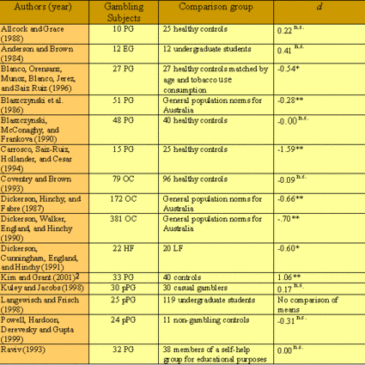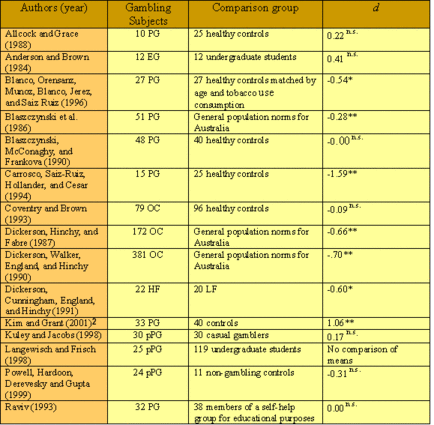Personality characteristics are some of the most noticeable aspects of the people we meet and might play a role in directing individuals’ behavior. Although many other factors also influence a person’s actual behavior, such as the social setting or specific powerful events, personality characteristics seem like they should be reliable predictors of future behavior. If so, then certain characteristics would associate with certain behavior patterns, such as thrillseeking associating with pathological gambling. Zuckerman (1994) recognized and quantified sensation seeking as one important attribute of personality; he described sensation seeking as a “trait defined by the need for varied, novel and complex sensations and experiences and the willingness to take physical and social risks for the sake of such experience” (Zuckerman, 1979, p. 10). Because gambling can involve risk-taking, excitement and a thrill – the very qualities Zuckerman associated with sensation seeking – some observers suggest that pathological gamblers would exhibit higher levels of these characteristics as compared to non-pathological gamblers. Using studies released between 1970 and 2003, Hammelstein (2004) conducted a meta-analysis of the relationship between sensation seeking and pathological gambling.
Hammelstein consulted PsycINFO and MEDLINE databases for the period between January 1970 and July 2003, searching for citations that compared pathological gamblers without additional psychological diagnoses to control participants on measures of sensation seeking. The author found fifteen such studies1. All of these studies except one tested subjects for sensation seeking preferences using Zuckerman’s Sensation Seeking Scale – Form V (SSS-V) (1994). The SSS-V consists of four factors: thrill and adventure seeking (TAS), experience seeking (ES), disinhibition (Dis) and boredom susceptibility (BS). Table 1 summarizes all 15 studies.
Table 1. Comparison of pathological gamblers with control subjects regarding sensation seeking as measured with SSS-V (adapted from Hammelstein, 2004).
*p < 0.05; ** p < 0.01; n.s. = non-significant.
Notes: d = effect size (i.e., the difference of total scores of sensation seeking divided by the pooled standard deviation). Negative values of d indicate that the gambling subjects reported lower levels of sensation seeking than the comparison group.
PG = pathological gamblers meeting DSM criteria;
EG/HF = experienced or high frequency gamblers;
LF = low frequency gamblers;
pPG = probable pathological gamblers (scoring >= 7 on the “Gamblers Anonymous 20 Questions or >=5 on the SOGS);
OC = off-course gamblers who bet on race tracks from a non-race course location.
Table 1 reveals that only one of the 15 studies study revealed a significant positive relationship between gambling problems and sensation seeking. Six studies revealed a significant negative relationship (i.e., pathological gamblers scored significantly lower than comparison groups); seven studies found no difference in sensation seeking between the gambling group and the control group. The remaining study did not test the difference between groups. The only study (Kim & Grant, 2001) that found a significant positive relationship used the TPQ, as opposed to the SSS-V, to measure sensation seeking. This review suggests that pathological gambling is not related to higher levels of sensation seeking, when the dependent measure is the SSS-V.
While this study made a strong case for dismissing connections between sensation seeking (as measured through the SSS-V) and pathological gambling, many of these studies used gambling groups and comparison groups that may not be representative of pathological gamblers or normal controls. Firstly, many of the gambling groups did not satisfy DSM (American Psychiatric Association, 1980) or SOGS (Lesieur & Blume, 1987) criteria and might not be representative of gamblers with clinical problems. Secondly, comparison groups varied from undergraduates to casual gamblers to general population norms. These points suggest that the gambling and control groups might vary so much that differences between these groups might be hard to detect3. Also, the author did not compare SSS-V subscale scores across studies. Perhaps individual subscales might be more sensitive to differences between
gamblers and controls. Finally, the wide use of the SSS-V among researchers precluded finding studies that used other instruments. Studies using other measures of sensation seeking (e.g., AISS-V or TPQ-NS) might produce different results.
Earlier, we suggested that an individual’s personality characteristics should predict future behavior patterns; however, in this case, a person who exhibits high sensation seeking characteristics, as measured by the SSS-V, would probably not have a greater probability of being a pathological gambler. In fact, the author discovered a small, but significant negative relationship between higher SSS-V scores and pathological gambling. This small, but negative, effect suggests that gamblers with problems do not seek higher levels of sensation and sensation seeking, as defined by Zuckerman’s SSS-V. More likely, the excitement associated with gambling for pathological gamblers serves as an anodyne for dysthymic or depressed feelings, a way to control or manage feelings, or something else entirely. More research is necessary to untangle this thorny problem.
Comments on this article can be addressed to Michael Stanton.
Notes
1. These “problem” gamblers varied by study. Seven studies sampled pathological gamblers, three studies sampled probable pathological gamblers, two studies sampled experienced high-frequency gamblers, and three studies sampled off-course bettors.
2. As opposed to the other studies presented here, this study used the Tridimensional Personality Questionnaire (TPQ) to measure sensation seeking.
3. On the other hand, a robust effect might have overcome this obstacle.
References
American Psychiatric Association. (1980). DSM-III: Diagnostic and statistical manual of mental disorders (Third ed.). Washington, D.C.: American Psychiatric Association.
Hammelstein, P. (2004). Faites vos jeux! Another look at sensation seeking and pathological gambling. Personality and Individual Differences, 37, 917-931.
Kim, S. W., & Grant, J. E. (2001). Personality dimensions in pathological gambling disorder and obsessive-compulsive disorder. Psychiatry Research, 104(3), 205-212.
Lesieur, H. R., & Blume, S. B. (1987). The South Oaks Gambling Screen (SOGS): A new instrument for the identification of pathological gamblers. American Journal of Psychiatry, 144(9), 1184-1188.
Zuckerman, M. (1979). Sensation seeking: Beyond the optimal level of arousal. Hillsdale: Lawrence Erlbaum.
Zuckerman, M. (1994). Behavioral expresisons and biosocial bases of sensation seeking. New York: Cambridge University Press.





